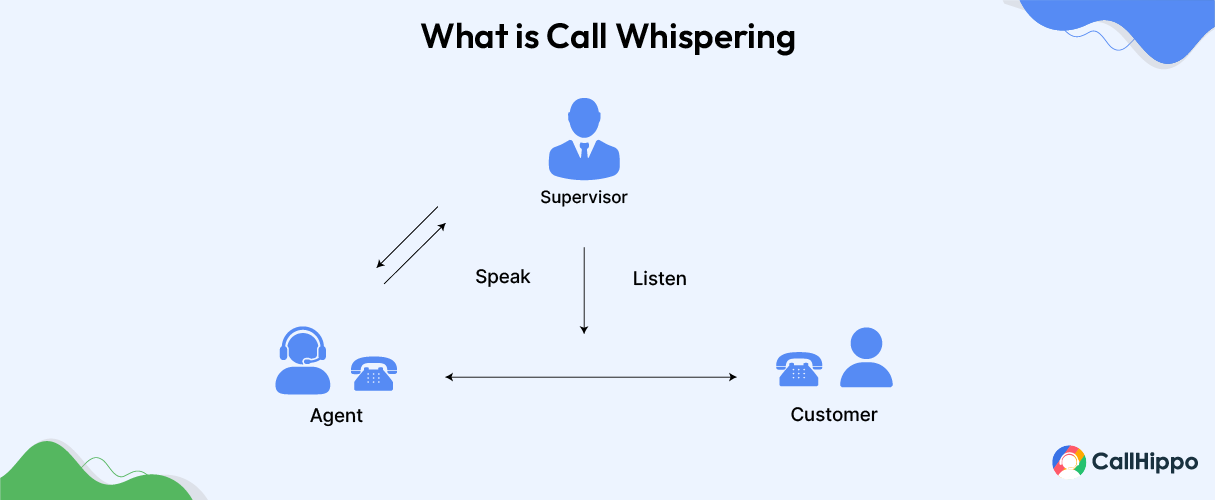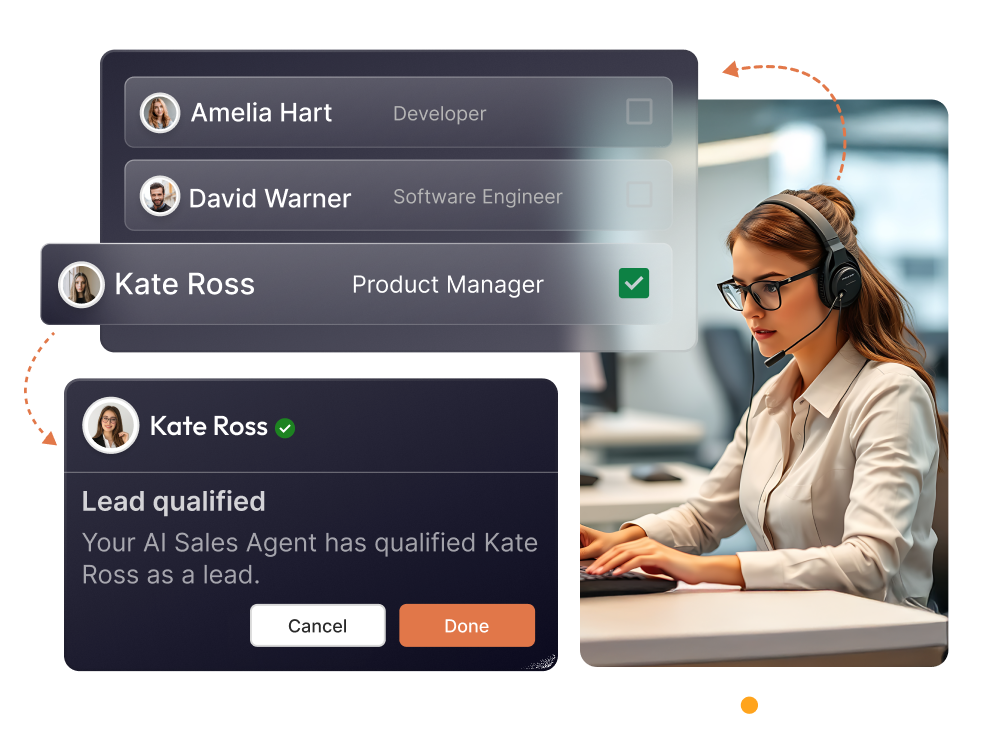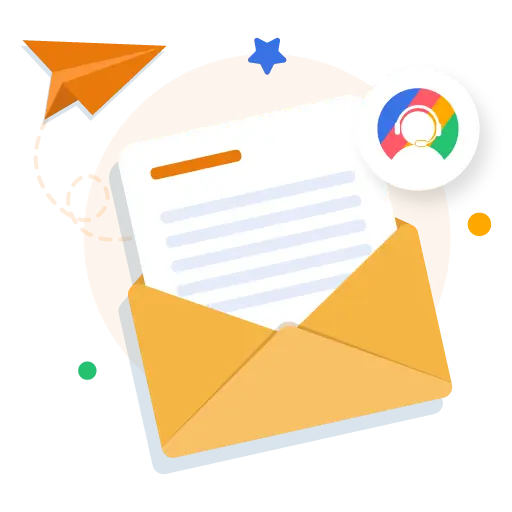In every customer phone conversation, there’s a moment where your business can make a strong impression or miss the mark. That’s why it’s not just about what your agents say. It’s also about how well they’re supported.
Imagine if a manager could empower an employee in real-time while a customer was on the line. Sounds beneficial, right? That’s the aim of call whispering: providing agents with the information they need to handle calls confidently.
In this blog, we’ll be outlining what is call whispering and why it is one of the most desired methods of improving customer service.
No Time for a 5-Minutes Read? Get the AI overview in 10 Seconds
Call whispering is a feature in call center software that allows managers or supervisors to speak to agents during a live call without the customer ever hearing it. The goal is simple. It helps agents perform better and gives customers a smoother experience.
- Benefits Of Call Whispering
- Improves Agent Performance: Agents get helpful context before and during calls, like customer history or campaign details, making their responses faster, more accurate, and personalized.
- Improves Real-Time Coaching: Supervisors can jump in quietly during tricky calls to coach agents without interrupting the flow, making training more effective.
- Enhances Customer Experience: When agents are better prepared and more confident, customers get better service and don’t need to repeat themselves..
- How is Call Whispering Different from Other Call Features?
Unlike call monitoring, which is passive, or call barging, where a manager jumps into the call and speaks to the customer, call whispering is subtle and silent to the customer. It lets supervisors guide without stepping in, making it perfect for real-time coaching with minimal disruption.
What Is Call Whispering?
Call whisper is a feature of contact center software that provides agents with important information about an incoming call. The information can be given either before the call begins or during the actual interaction, without the caller knowing.

This information can come in several formats, including a display message, a voice recording, or even text-to-speech. The call whisper feature also allows a manager or supervisor to quietly provide real-time guidance to the agent while on the call. The call whisper service has created many benefits for agents, supervisors, and the contact center overall.
Benefits of Call Whispering
Call whispering is a way for teams to improve how they communicate with customers. Here are some of the key benefits of call whispering:
1. Improving Agent Performance And Readiness
The positive effect on agent readiness and performance is one of the key benefits of call whispering. Agents get important caller details like the following:
- The reason for the call
- Customer preferences and contact history
- Account status
- Past interactions
With that context, agents start the call knowing the situation, which leads to:
- Faster and more accurate responses
- More confident call handling
- Personalized and on-brand communication
2. Whisper Call Tracking and Marketing Insights
Call whispering also provides whisper call tracking, which connects inbound calls to a specific marketing campaign. This allows businesses to:
- Understand what channels or ads were responsible for driving calls,
- Refine marketing activities based on which channels converted better, and
- Allocate the budget more efficiently.
It’s like every call becomes a smart learning experience for agents and the marketing team.
3. Improved Customer Experience
Call whispering directly contributes to improving customer experience by allowing agents to offer:
- Prompt and attentive service from the call center managers
- Personalized responses based on previous touchpoints
- Faster solutions that reduce hold times
Customers also don’t have to repeat themselves as much, which helps them feel seen and respected during the interaction. With more new context and preparation, the agent is more likely to solve the problem on the first call, leading to improved First Call Resolution (FCR) and overall satisfaction.
4. Operational Efficiency for Contact Centers
From an operations perspective, the value of call whispering can be seen in the following:
- Up to a 25% increase in call resolution rates
- Lower Average Handle Time (AHT)
- Fewer escalations to management
- Better call flow with fewer transfers
Call whispering can provide useful information to identify recurring pain points from customers, track points of contention in the customer journey, and identify gaps where agents may need additional training.
5. Real-Time Coaching and Monitoring for Managers
Call whispering is a useful coaching tool for supervisors. With call whispering, supervisors can:
- Evaluate many agent calls while listening live
- Quickly provide agents with private coaching
- Monitor agent performance without interrupting the call
Call whispering and proactive coaching to train call center agents is beneficial for agents to not go off track and limit escalation calls. Managers can collect whisper data to improve routing, review the effectiveness of agent IVR menus, and enhance quality assurance.
With CallHippo!
- No More Confused Clients
- No More Frustrated Customers
- Manage conversations

Call Whisper Comparison With Other Key Features
In the table below, we’ll compare some of the key call center software features like call monitoring, call tracking, call barging, and call takeover with call whispering. These comparisons highlight the unique functionality and purpose of a call whisper service within the broader scope of contact center operations.
| Feature | Call Whisper | Call Monitoring | Call Tracking | Call Barging | Call Takeover |
|---|---|---|---|---|---|
| Definition | Supervisor privately guides agent during a live call (customer can't hear) | Supervisor listens to live or recorded calls without participating | Collecting and analyzing call data for marketing and operational insights | Supervisor joins the live call and speaks with both the agent and the customer | The supervisor takes full control of the call, agent is disconnected |
| Purpose | Real-time coaching, improve call handling, and increase the success rate | Quality control, performance review, and training needs assessment | Understand marketing ROI, track call sources, and campaign performance | Rescue or support during difficult calls, handle escalations | Handle high-stakes or escalated situations directly |
| Who Can Hear | Only the agent | Supervisor only | Not applicable (data-driven) | The agent and the customer can both hear the supervisor | Only the customer hears the supervisor |
| Level of Intervention | Low guidance only | None: passive listening | None: analytical insight only | Medium: active support | High: full control and resolution |
| Real-Time? | Yes | Sometimes (live or post-call) | No | Yes | Yes |
| Customer Aware? | No | No | Not applicable | Yes | Yes |
Key Use Cases For Call Whispering In Call Centers
We’ll now discuss some of the use cases for call whisper, highlighting its versatility and benefits across various aspects of call center operations. These examples demonstrate how call whisper is a valuable feature and plays a vital role in improving agent performance, enhancing customer experience, and optimizing business outcomes.
1. TNCSA Shortens Agent Training Time with Call Whisper
The Tennessee Community Services Agency (TNCSA) uses call whisper technology to speed up the onboarding of new agents. Instead of relying solely on in-class training or shadowing existing agents, supervisors use live call whisper technology to coach new hires as they are on live calls.
This method of real-time agent training greatly reduces the ramp-up time while still being able to deliver the same level of service.
- At CallHippo, we found a 30% increase in First Call Resolution for clients that employed whisper coaching as part of their onboarding. In one case, a sales team increased its close rate for deals by 40% in Q2 using whisper prompts along with call insights from its CRM.
2. Atmosphere’s Sales Team Closes More Deals Using Live Whisper
At Atmosphere, their sales team is actively and in real-time using call whisper technology as they are selling in high-stakes sales conversations. Sales managers whisper things like how to handle objections, position the product, and timing for when to close, using calling whisper technology.
They communicate with new call center agents without the customer being aware. The addition of live coaching to the sales process easily blends with their ability to convert important deals.
3. Whisper Coaching Helps Agents Handle Medicare Compliance Calls
In different regulated calls, such as Medicare Sales conversations, a supervisor can use call whisper technology to provide real-time compliance reminders, making sure an agent has mentioned all of the legally required disclosures and followed the script without violating any regulations.
There are many different compliance industries where a minor mistake can result in a company facing fines in the thousands.
4. Tracking Ad Campaigns in Real Time with Whisper Call Tracking
Agents communicate through whisper messages on the source of the customer’s call, down to the exact ad, keyword, or CTA.
This is important for businesses, including marketing agencies or performance-driven teams. It allows them to quickly quantify and evaluate marketing campaigns so they can rapidly adjust their strategies.
5. Live Support During Crisis Calls to Help De-Escalate
In challenging emotional or crisis, call whisper allows supervisors to provide real-time guidance without an interruption in the flow of conversation.
Agents receive suggestions on tone, possible de-escalation phrases, or next steps, helping to ensure sensitive situations are diffused calmly and professionally.
How Call Whisper Works in Contact Centers?
Implementation of a call whisper in a contact center is multi-faceted, involving technical setup, customized messaging, and potentially real-time support during a call. The call whisper process provides agents with helpful context before they answer a call, allowing them to respond more quickly and more effectively. Let’s dive into implementation details:
1. Setup and Installation
Call whisper is added to a contact center’s phone system, whether cloud-based or on-premises. It can also be integrated directly with CRM systems.
- Managers or IT teams program custom whisper messages that provide agents with information before they take the call.
- These messages are customized to include information, such as the caller’s name, the reason for the call, or the source of the marketing campaign.
- In call tracking systems, agents are assigned unique phone numbers to each ad campaign. The whisper message lets the agent know which campaign prompted the call.
2. How It Works During a Call
Once a call comes in, and the whisper feature is triggered, the agent receives a private message before connecting with the customer. These messages can be delivered as:
- A screen pop-up
- A pre-recorded voice message
- A text-to-speech announcement
Information can include:
- Caller name and contact info
- Status (e.g., new, VIP, returning customer)
- Reason for the call or campaign source
- Language preferences or urgency level
- Internal handling tips or agent-specific instructions
3. Live Call Whispering (Manager-Led Whisper)
In some cases, a supervisor listens in on live calls and provides direct coaching to the agent during the conversation, without the customer hearing it. This live whispering helps agents:
- Handle objections more confidently
- Follow compliance or escalation procedures.
- Navigate difficult or high-stakes interactions in real time.
4. Automated Support Using AI Tools
Some systems use AI-powered bots to pull CRM data and automatically deliver whisper messages. These bots can analyze IVR input, campaign tags, or customer history to generate accurate, real-time context for the agent, either before or during the call.
5. Types of Call Whisper Implementations
- Standard Whisper: Pre-call messages with basic customer info pulled from CRM or IVR.
- Live Whisper: Supervisor-guided coaching during live conversations.
- Automated Whisper: System-generated messages triggered by campaign, CRM, or IVR data.
- Call whisper is most effective when paired with other tools, like several call center features like call monitoring and call recording.
- Supervisors use call monitoring to know when to jump in with a whisper.
- Recordings from past calls help train agents and improve whisper messaging.
- Insights from whisper interactions also guide improvements in IVR menus, call routing, and agent training.
Top Features of A Call Whisper Service
If you’re looking to add call whispering to your business, here are the top features to look for in a good call center whisper service:
- Live Listening & Whisper Mode: Ability to tune into live calls and whisper to agents in real time.
- Call Center Integration: Seamless setup with your existing call center platform or phone system. CRM integrations like Salesforce or Zoho can automatically feed campaign data into whisper messages.
- Role-Based Access: Only team leads or managers can use the feature.
- Performance Metrics: Combine it with whisper call tracking to see if your real-time coaching improves call quality, customer satisfaction, or conversions.
- Call Recording with Whisper Tags: Recordings that mark where whispering happened so that you can review those parts later for training.
| Potential Disadvantages of Call Whispering Listed below are some potential disadvantages of call whispering. Let’s know about them: 1. Risk of Agent Distraction During Live CallsA major concern is the risk of agents becoming distracted when receiving whispered instructions from a manager during a live call. Their focus will shift to splitting their attention between the customer and processing what their supervisor is saying to them. A mental juggling act like this can be difficult, especially if the conversation is fast-paced or emotionally charged. 2. Slower Response Times and Conversation FlowWhen agents take time to reflect on guidance provided by a supervisor, it can cause delays in responding to the customer for the agent. These brief pauses in the conversation could make the caller feel uncomfortable, thereby impacting the call quality of the call. To minimize this, managers will want to use whispers that are short, succinct, and simple to enhance rather than interrupt the flow of conversation. 3. Risk of Over-Reliance on Call WhisperingAnother aspect of agent support that could be problematic is dependency. If the call whisper system is available on every call, the agent’s knowledge could only rely heavily on this voice, inhibiting their ability to build confidence and develop judgment. To mitigate this outcome, supervisors should explain clearly during onboarding that whisper support is available to support complex or sensitive calls, as opposed to using it on every call. It should be positioned more like training wheels, not a new part of the agent’s call handling process. |
Note: Call whispering must be used with an appropriate consent agreement. Supervisors and agents should be aware of the privacy rules (e.g., HIPAA, GDPR) to ensure compliance risk is avoided, which can be significant in sensitive industries such as healthcare or finance.
Conclusion
If conversations with customers drive your organization, then providing your staff with the tools to be able to successfully manage those conversations is a smart move. Call whispering provides that back-end reassurance, helping improve agents’ confidence, ensuring customer satisfaction, and allowing intuitive training.
Whether you are in sales, support, or a fully-fledged call centre, a professional call whisper service can play an important role in call handling skills and giving you the competitive edge you’d like your organization to have.
And when combined with whisper call tracking, you are not simply assisting your team but are also collecting essential insights into what works and what does not. That is a win for the agent, the customer, and the business itself.
FAQs
1. Is call whispering legal for businesses?
Yes, in most regions it’s legal, especially if the call is already being recorded for training or quality purposes. But laws vary by country and state, so it’s always good to check local call monitoring rules and disclose call recording if needed.
2. Can the customer hear a call whisper message?
No. Only the agent hears the whisper. The customer continues the conversation without any idea that support is being given behind the scenes.
3. Can whispering be used for training new agents?
Yes, call whispering can be used for training new agents. This hands-on coaching style helps agents build confidence faster and make fewer mistakes.

Subscribe to our newsletter & never miss our latest news and promotions.









